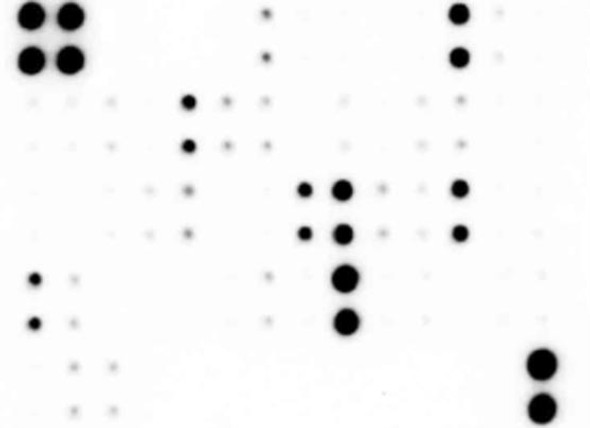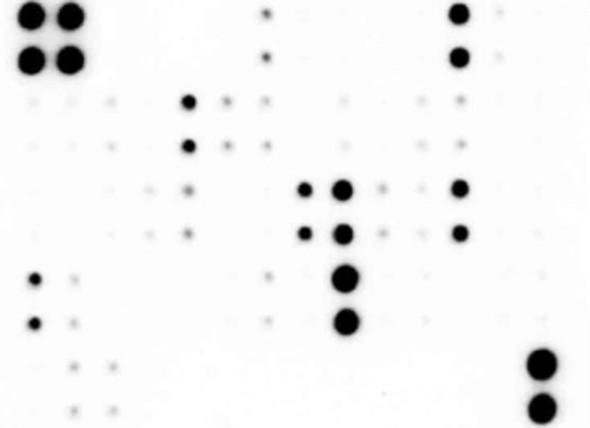Human AKI Array (20 targets) (SARB0016)
- SKU:
- SARB0016
- Product Type:
- Protein Array
- Analytes:
- TIM-1 (KIM-1)
- Albumin
- Osteopontin (SPP1)
- TFF3 (Trefoil Factor 3)
- Beta-2 Microglobulin
- Clusterin
- CXCL16
- Osteoactivin (GPNMB)
- FABP1
- MCP-1 (CCL2)
- TNF RI (TNFRSF1A)
- Calbindin
- IP-10 (CXCL10)
- Cystatin C
- HGF
- MIF
- Lipocalin-2 (NGAL)
- TIMP-1
- VCAM-1 (CD106)
- VEGF-A
- Reactivity:
- Human
- Applications:
- Multiplex Array
Description
Human AKI Array (20 targets) (SARB0016)
The Human AKI Array (SARB0016) is a comprehensive tool for researchers studying acute kidney injury (AKI), a common and serious condition that can lead to kidney failure if not promptly treated. This array kit contains 20 targets related to AKI, including cytokines, chemokines, and growth factors, allowing for a thorough analysis of the molecular pathways involved in this condition.By utilizing this array, researchers can gain insights into the inflammatory response, tissue damage, and repair processes that occur in AKI.
The kit is specifically designed for use with human samples, ensuring accurate and reliable results for studies focused on human AKI.With the Human AKI Array, researchers can identify potential biomarkers, therapeutic targets, and pathways for intervention in AKI. This kit is a valuable tool for advancing our understanding of this complex condition and developing new strategies for its diagnosis and treatment.
| Product Sku: | SARB0016 |
| Size: | 2, 4, or 8 |
| Species Detected: | Human |
| Number of Targets Detected: | 20 |
| Gene Symbols: | ALB, B2M, CALB1, CCL2, CLU, CST3, CXCL10, CXCL16, FABP1, GPNMB|HAVCR1, HGF, LCN2, MIF, SPP1, TFF3, TIMP1, TNFRSF1A, VCAM1, VEGFA |
| Compatible Sample Types: | Cell Culture Supernatants, Cell Lysates, Plasma, Serum, Tissue Lysates |
| Design Principle: | Sandwich-based |
| Method of Detection: | Chemiluminescence |
| Pathway: | |
| Quantitative/Semi-Quantitative: | Semi-Quantitative |
| Solid Support: | Membrane |
| Suggested Application(s): | Multiplexed Protein Detection; Detection of Relative Protein Expression; Detecting Patterns of Cytokine Expression; Biomarker/ Key Factor Screening; Identifying Key Factors; Confirming a Biological Process; Detecting Nephrotoxicity |
| Storage/Stability: | For best results, store the entire kit frozen at -20°C upon arrival. Stored frozen, the kit will be stable for at least 6 months which is the duration of the product warranty period. Once thawed, store array membranes and 1X Blocking Buffer at -20°C and all other reagents undiluted at 4°C for no more than 3 months. |
| Hover over target for more information | ||||
|---|---|---|---|---|
TIM-1 (KIM-1)
| Albumin
| Osteopontin (SPP1)
| TFF3 (Trefoil Factor 3)
| Beta-2 Microglobulin
|
Clusterin
| CXCL16
| Osteoactivin (GPNMB)
| FABP1
| MCP-1 (CCL2)
|
TNF RI (TNFRSF1A)
| Calbindin
| IP-10 (CXCL10)
| Cystatin C
| HGF
|
MIF
| Lipocalin-2 (NGAL)
| TIMP-1
| VCAM-1 (CD106)
| VEGF-A
|
- Easy to use
- No specialized equipment needed
- Compatible with nearly any liquid sample
- Proven technology
- Highly sensitive (pg/ml)
- Sandwich ELISA specificity
- Higher density than ELISA, Western blot or bead-based multiplex
- Human Acute Kidney Injury (AKI) Antibody Array C1 Membranes
- Blocking Buffer
- Wash Buffer 1
- Wash Buffer 2
- Biotinylated Detection Antibody Cocktail
- Streptavidin-Conjugated HRP
- Detection Buffer C
- Detection Buffer D
- Lysis Buffer
- 8-Well Incubation Tray
- Plastic Sheets
- Array Templates
Other Materials Required
- Pipettors, pipet tips and other common lab consumables
- Orbital shaker or oscillating rocker
- Tissue Paper, blotting paper or chromatography paper
- Adhesive tape or Saran Wrap
- Distilled or de-ionized water
- A chemiluminescent blot documentation system , X-ray Film and a suitable film processor, or another chemiluminescent detection system.
| 1. | Block membranes |
| 2. | Incubate with Sample |
| 3. | Incubate with Biotinylated Detection Antibody Cocktail |
| 4. | Incubate with HRP-Conjugated Streptavidin |
| 5. | Incubate with Detection Buffers |
| 6. | Image with chemiluminescent imaging system |
| 7. | Perform densitometry and analysis |










